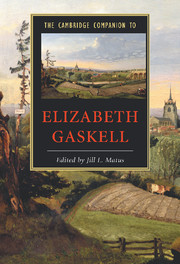Book contents
- Frontmatter
- 1 Introduction
- 2 The life and letters of E. C. Gaskell
- 3 Mary Barton and North and South
- 4 Cranford and Ruth
- 5 Elizabeth Gaskell’s The Life of Charlotte Brontë
- 6 Sylvia’s Lovers and other historical fiction
- 7 Cousin Phillis, Wives and Daughters, and modernity
- 8 Elizabeth Gaskell’s shorter pieces
- 9 Gaskell, gender, and the family
- 10 Elizabeth Gaskell and social transformation
- 11 Unitarian dissent
- 12 Gaskell then and now
- Guide to further reading
- Index
- Series List
9 - Gaskell, gender, and the family
Published online by Cambridge University Press: 28 May 2007
- Frontmatter
- 1 Introduction
- 2 The life and letters of E. C. Gaskell
- 3 Mary Barton and North and South
- 4 Cranford and Ruth
- 5 Elizabeth Gaskell’s The Life of Charlotte Brontë
- 6 Sylvia’s Lovers and other historical fiction
- 7 Cousin Phillis, Wives and Daughters, and modernity
- 8 Elizabeth Gaskell’s shorter pieces
- 9 Gaskell, gender, and the family
- 10 Elizabeth Gaskell and social transformation
- 11 Unitarian dissent
- 12 Gaskell then and now
- Guide to further reading
- Index
- Series List
Summary
“All else confusion”?: gender and social expectations
Man for the field and woman for the hearth:
Man for the sword and for the needle she:
Man with the head and woman with the heart:
Man to command and woman to obey;
All else confusion.
Alfred, Lord Tennyson, The Princess (1847)When Alfred, Lord Tennyson published The Princess in 1847, just as Elizabeth Gaskell was starting her writing career, it was to challenge attitudes like those expressed by the old king in these lines, and Tennyson was not alone in feeling that the doctrine known as ''separate spheres'' for men and women was ripe for change. Indeed, by 1865, the year of Gaskell's death, John Stuart Mill was able to present the first women's suffrage amendment in parliament. Nevertheless, Mill's speech, published in 1869 as The Subjection of Women, confirms that general assumptions about women's role had not changed: “[a]ll the moralities tell them that it is the duty of women, and all the current sentimentalities that it is their nature, to live for others; to make complete abnegation of themselves, and to have no life but in their affections.”
One book in this tradition, published in 1839, when Gaskell was the mother of two small daughters, was Sarah Lewis's Woman's Mission. While Christian missionaries find their vocation among the heathen, Lewis argues, ''woman's mission'' is at home, exerting a beneficial influence on her menfolk. In particular, Lewis stresses the importance of mothers inculcating in their male children values of mutual respect, responsibility, and compassion before they pass beyond their mothers' influence into the public world.
- Type
- Chapter
- Information
- The Cambridge Companion to Elizabeth Gaskell , pp. 131 - 147Publisher: Cambridge University PressPrint publication year: 2007
- 3
- Cited by



